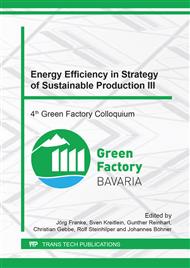[1]
U. Bierbaum, J. Hütter, Druckluft-Kompendium, 6th ed., Darmstadt: Hoppenstedt Bonnier Zeitschriften, (2004).
Google Scholar
[2]
H. Murrenhoff, W. Gauchel, Umdruck zur Vorlesung Grundlagen der Fluidtechnik, 2nd ed., vol. 3, Reihe Fluidtechnik, Aachen: Shaker, (2006).
Google Scholar
[3]
H. Watter, Hydraulik und Pneumatik: Grundlagen und Übungen - Anwendungen und Simulation, 4th ed., Wiesbaden: Springer Vieweg, (2015).
DOI: 10.1007/978-3-658-07860-7
Google Scholar
[4]
M. Bahr, E. Ruppelt, Taschenbuch Drucklufttechnik, Essen: Vulkan-Verl., (2000).
Google Scholar
[5]
W. Kalide, H. Sigloch, Energieumwandlung in Kraft- und Arbeitsmaschinen: Kolbenmaschinen - Strömungsmaschinen - Kraftwerke, 10th ed., München: Hanser, (2010).
DOI: 10.3139/9783446461222.fm
Google Scholar
[6]
Atlas Copco Kompressoren GmBH, Handbuch der Drucklufttechnik, 7th ed., Essen: Atlas Copco Kompressoren GmbH Communications, (2009).
DOI: 10.1007/s35144-018-0419-9
Google Scholar
[7]
H. -W. Grollius, Grundlagen der Pneumatik: Mit 20 Aufgaben, 2nd ed., Fachbuchverlag Leipzig im Carl Hanser Verlag, (2009).
Google Scholar
[8]
K. Menny, Strömungsmaschinen: Hydraulische und thermische Kraft- und Arbeitsmaschinen ; mit 36 Tabellen und 47 Beispielen, 5th ed., Lehrbuch Maschinenbau, Wiesbaden: Teubner, (2011).
Google Scholar
[9]
FESTO, Pneumatikzylinder: Festo Wiki, (2013).
Google Scholar
[10]
P. Croser, F. Ebel, Pneumatik - Grundstufe, Berlin Heidelberg New York: Springer-Verlag, (2013).
Google Scholar
[11]
B. Heinrich, P. Linke, M. Glöckler, Grundlagen Automatisierung, Wiesbaden: Springer Vieweg, (2015).
Google Scholar
[12]
G. Wellenreuther, D. Zastrow, Automatisieren mit SPS - Theorie und Praxis - Programmierung: DIN EN 61131-3, STEP7, CoDeSys, Entwurfsverfahren, Bausteinbibliotheken. Applikationen: Steuerungen, Regelungen, Antriebe, Safety. Kommunikation: AS-i-Bus, PROFIBUS, EthernetTCP/IP, PROFINET, Web-Technologien, OPC, WLAN, 5th ed., Wiesbaden: Vieweg+Teubner Verlag, (2014).
DOI: 10.1007/978-3-8348-2598-8_3
Google Scholar
[13]
J. Langer, M. Roland, Anwendungen und Technik von Near Field Communication (NFC), Berlin, Heidelberg: Springer-Verlag Berlin Heidelberg, (2010).
DOI: 10.1007/978-3-642-05497-6
Google Scholar
[14]
T. Heimbold, Einführung in die Automatisierungstechnik: Automatisierungssysteme, Komponenten, Projektierung und Planung ; mit 43 Tabellen, München: Fachbuchverl. Leipzig im CarlHanser-Verl., (2015).
DOI: 10.3139/9783446431355.fm
Google Scholar
[15]
D. Schmid et al., Automatisierungstechnik: Grundlagen, Komponenten und Systeme ; mit CD für Bilder, Übungen, Aufgaben und Simulationen, 11th ed., Bibliothek des technischen Wissens, Haan-Gruiten: Verlag Europa-Lehrmittel - Nourney Vollmer GmbH & Co. KG, (2015).
DOI: 10.1002/food.19920360125
Google Scholar
[16]
T. Rackow et al., Energy Flexible Production: Saving Electricity Expenditures by Adjusting the Production Plan, in: Procedia CIRP, volume 26, (2015), pp.235-240.
DOI: 10.1016/j.procir.2014.07.179
Google Scholar
[17]
C. Schulz et al., Integration von Lastmanagementstrategien in die Produktionssteuerung, in: Zeitschrift für wirtschaftlichen Fabrikbetrieb, no. 11, (2015), 675-680.
DOI: 10.3139/104.111409
Google Scholar
[18]
K. -H. Grote et al., Das Ingenieurwissen: Entwicklung, Konstruktion und Produktion, 1st ed., Berlin Heidelberg New York: Springer-Verlag, (2014).
Google Scholar
[19]
S. Schenk, M. Schenk, Produktion und Logistik mit Zukunft - Digital Engineering and Operation, 1st ed., Berlin Heidelberg New York: Springer-Verlag, (2015).
DOI: 10.1007/978-3-662-48266-7
Google Scholar
[20]
A. Sauer, T. Bauernhansl, Energieeffizienz in Deutschland - eine Metastudie - Analyse und Empfehlungen, 2nd ed., Berlin Heidelberg New York: Springer-Verlag, (2017).
DOI: 10.1007/978-3-642-55173-4
Google Scholar
[21]
S. von Roon, T. Gobmaier, Demand Response in der Industrie - Status und Potenziale in Deutschland, tech. rep., Forschungsgesellschaft für Energiewirtschaft mbH, (2010).
Google Scholar
[22]
M. Weck, Werkzeugmaschinen 1 - Maschinenarten und Anwendungsbereiche, Berlin Heidelberg New York: Springer-Verlag, (2006).
Google Scholar


